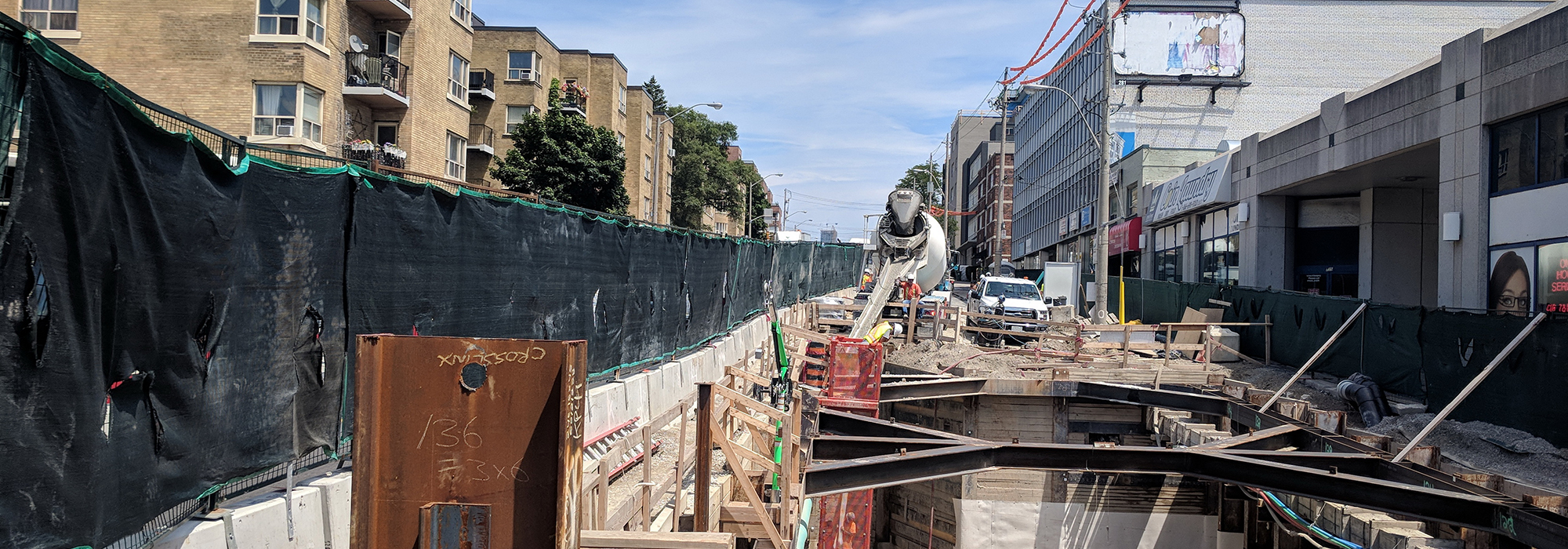
Community Benefit Agreements, or CBAs, offer a solution to the problem of growing income inequality. They bring physical, social and economic benefits to the local community through infrastructure and development projects or goods and services, including employment and training. They can be a way to elevate those at the bottom of the labour market who have disproportionately felt the burden of rising income inequality and the subsequent losses in access to opportunity.
United Way Greater Toronto’s research on income inequality in the Greater Toronto Area (GTA) reveals that no matter how we look at it, income inequality is growing — and growing faster in the Toronto region than across Canada. We also know that some of us bear more of the burden. Young adults in the GTA are more disadvantaged today than ever before. In real terms, on average, a young adult in Peel, Toronto or York was earning less in 2015 than in 1980 (Figure 1).
In the GTA, it also doesn’t matter how long a person’s been in Canada; if they weren’t born here, they are likely earning less. In real terms, immigrants in Peel, Toronto and York were, on average, making less in 2015 than 35 years ago (Figures 2, 3, 4 and 5).
And contrary to the popular narrative that diversity is our strength, the racial divide in the GTA is at a historic high, with racialized groups becoming poorer over time. In real terms, in 2015, racialized groups in Peel, Toronto, and York were earning less or similar to what they earned 35 years ago, with the gap most pronounced in the city of Toronto (Figure 6).
Income inequality undermines the “opportunity equation” — the understanding that individual effort plus access to opportunity equals success. Research shows that in a less equal society, circumstances that are beyond your control — the colour of your skin, the neighbourhood you grew up in — have greater influence on the opportunities that you have access to and ultimately your outcomes, particularly for people with very high or very low incomes. By making circumstances play a bigger role in determining the range of opportunities a person has access to, rising income inequality erodes fairness.
Although Canada is known as a place where the dream of social mobility remains alive, these findings show that in the GTA, it’s not available to everyone. There are growing gaps between the haves and the have nots, with each group defined by circumstances beyond their control. For the “haves,” those circumstances are an advantage; for the “have nots,” they become a barrier.
These gaps play out in the labour market. When it comes to employment and skills development, low-income workers, women, racialized groups and those without university educations are often left behind. In 2017, 37.1 percent of working age adults between the ages of 25-64 in the Greater Toronto and Hamilton Area (GTHA) worked in some degree of precarious employment. When the labour market improved between 2011 and 2017, white men and women and racialized men who had university degrees all gained in job security, while racialized women with university degrees and all groups without university degrees saw no gains in job security in the GTHA.
As income and opportunity gaps grow, targeted investments to support groups facing barriers to getting good stable jobs are increasingly important and receiving more focused attention. Currently, there are systems being designed and tested with regional workforce development groups operating throughout the GTA, and strategies being implemented by local governments. The Ontario government is modernizing the skills development and training systems in this province. In response to changing needs, the federal government has invested $225 million over four years, and $75 million per year thereafter to reimagine Canada’s skills development policies and programs through its Future Skills Centre and Council. It’s clear that there is an appetite to use workforce development strategies to make change.
Community Benefit Agreements are a workforce development initiative that leverage public infrastructure funding to improve community outcomes. The CBA model creates ladders to opportunity, with the support of multiple players — governments, civil society, the private sector, the community service sector, and labour — and coordinated actions. CBAs provide in-demand skills through apprenticeships and training, links to employers and good jobs, and wrap-around supports to ensure success. Aside from training and jobs, communities can also benefit through local social procurement.
The construction pathway on the Eglinton LRT — Ontario’s first large-scale public infrastructure project mandating direct local benefit — is a prime example. It cuts through neighbourhoods where many residents are low-income and experience multiple barriers to good employment such as being racialized, newcomers or women. As part of its commitment, the developer provides training and employment opportunities to these groups — career pathways and unionized jobs with decent wages. An integral component is the access to wrap-around supports such as mental health counselling, housing services, and childcare that are included to help ensure participants’ success. The developer also procures goods and services from local suppliers and social enterprises, whenever possible.
The unique and critical element of this CBA-driven career pathway model is the stakeholders who have come together to develop and implement it: the City of Toronto, the province of Ontario, labour, community, foundations, and United Way. United Way has played a crucial role in bringing together players from different sectors to work together to make sure that we engage, recruit, train, place and support people so they can take these opportunities and thrive. For example, the Career NavigatorTM program supports young people facing multiple barriers with wrap-around supports. And the results are promising. As of June 2019, there have been 268 total placements on the Eglinton LRT project: with 153 being professional, administrative and technical hires, and 115 being apprenticeships.
There are similar employment-focused CBAs modeled on the Eglinton LRT that are in various stages of development throughout the Greater Toronto Region that also build on important CBAs in the city of Vancouver and throughout the United States.
CBAs are a promising model with strong potential for scaling and replication. Investing in CBAs is smart policy: they are a cost-effective strategy that aren’t necessarily about increasing dollars but about leveraging existing work and working differently. There are already billions of dollars allocated to building transit in Toronto, and billions more that the province and the federal government have said they will spend over the next 10 years on infrastructure. Done right, these projects can have twice the impact, strengthening our civic infrastructure while also creating economic opportunities that can mitigate the impacts of income inequality.
This article is part of the Ensuring inclusive prosperity when all boats aren’t being lifted special feature.
Photo: Construction of the Eglinton Crosstown light-rail line at Bathurst St. and Eglinton Ave. in July 2018. It is Ontario’s first large-scale public infrastructure project mandating direct local benefit.
Do you have something to say about the article you just read? Be part of the Policy Options discussion, and send in your own submission. Here is a link on how to do it. | Souhaitez-vous réagir à cet article ? Joignez-vous aux débats d’Options politiques et soumettez-nous votre texte en suivant ces directives.









